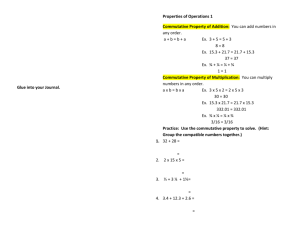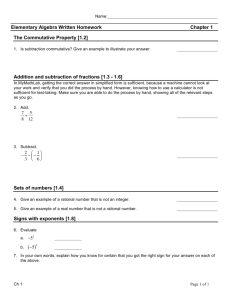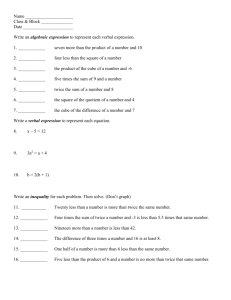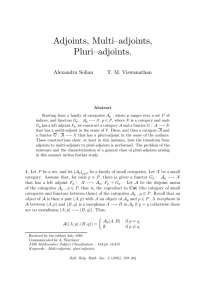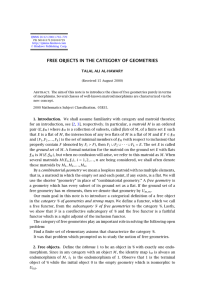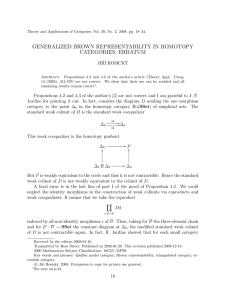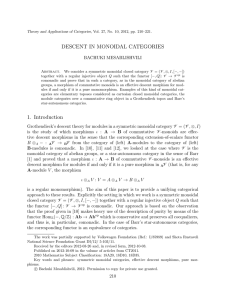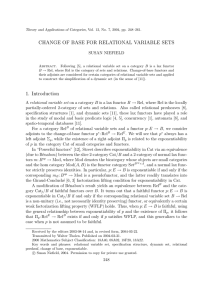ON SOME PROPERTIES OF PURE MORPHISMS OF COMMUTATIVE RINGS BACHUKI MESABLISHVILI
advertisement
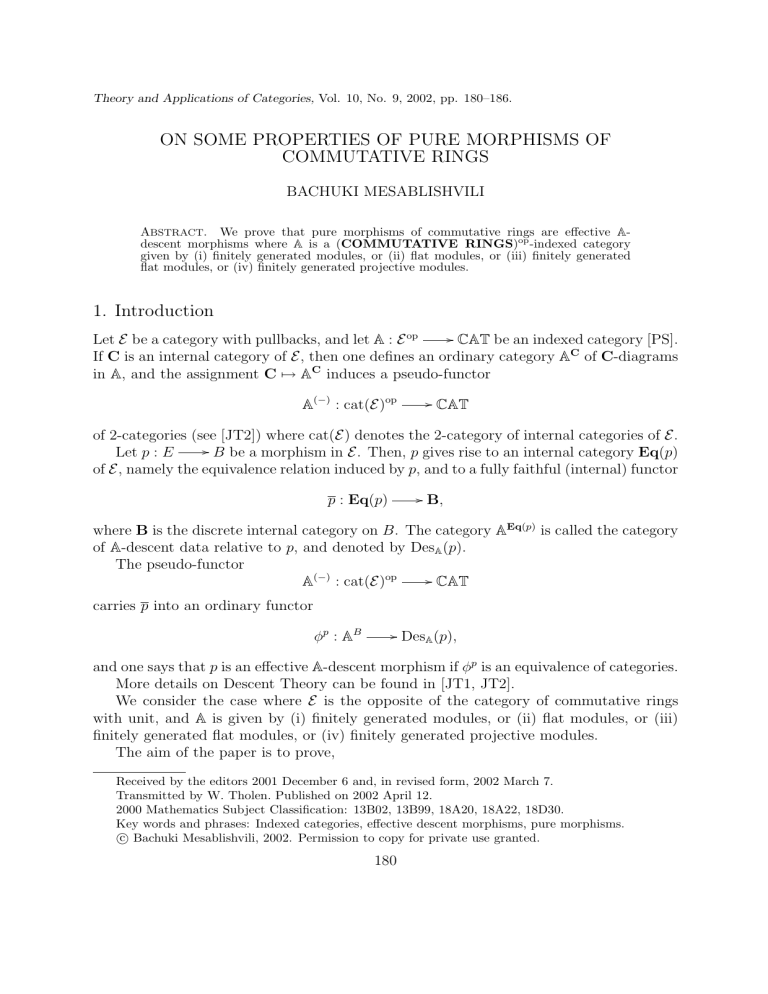
Theory and Applications of Categories, Vol. 10, No. 9, 2002, pp. 180–186.
ON SOME PROPERTIES OF PURE MORPHISMS OF
COMMUTATIVE RINGS
BACHUKI MESABLISHVILI
ABSTRACT. We prove that pure morphisms of commutative rings are effective Adescent morphisms where A is a (COMMUTATIVE RINGS)op -indexed category
given by (i) finitely generated modules, or (ii) flat modules, or (iii) finitely generated
flat modules, or (iv) finitely generated projective modules.
1. Introduction
/ CAT be an indexed category [PS].
Let E be a category with pullbacks, and let A : E op
If C is an internal category of E, then one defines an ordinary category AC of C-diagrams
in A, and the assignment C → AC induces a pseudo-functor
A(−) : cat(E)op
/ CAT
of 2-categories (see [JT2]) where cat(E) denotes the 2-category of internal categories of E.
/ B be a morphism in E. Then, p gives rise to an internal category Eq(p)
Let p : E
of E, namely the equivalence relation induced by p, and to a fully faithful (internal) functor
p : Eq(p)
/ B,
where B is the discrete internal category on B. The category AEq(p) is called the category
of A-descent data relative to p, and denoted by DesA (p).
The pseudo-functor
/ CAT
A(−) : cat(E)op
carries p into an ordinary functor
φp : AB
/ DesA (p),
and one says that p is an effective A-descent morphism if φp is an equivalence of categories.
More details on Descent Theory can be found in [JT1, JT2].
We consider the case where E is the opposite of the category of commutative rings
with unit, and A is given by (i) finitely generated modules, or (ii) flat modules, or (iii)
finitely generated flat modules, or (iv) finitely generated projective modules.
The aim of the paper is to prove,
Received by the editors 2001 December 6 and, in revised form, 2002 March 7.
Transmitted by W. Tholen. Published on 2002 April 12.
2000 Mathematics Subject Classification: 13B02, 13B99, 18A20, 18A22, 18D30.
Key words and phrases: Indexed categories, effective descent morphisms, pure morphisms.
c Bachuki Mesablishvili, 2002. Permission to copy for private use granted.
180
PURE MORPHISMS OF COMMUTATIVE RINGS
181
/ S be a pure morphism of commutative rings with unit.
1.1. Theorem. Let f : R
Then f is an effective A-descent morphism.
2. Preliminaries
Let E be a category with pullbacks and let
A, B : E op
/ CAT
be E-indexed categories. We say that A is an E-indexed full subcategory of B if there exists
/ B such that the functor F (e) : Ae
/ Be , e ∈ Ob(E),
an E-indexed functor F : A
is a fully faithful embedding.
The key role in proving the main result will be Corollary 2.7 of [JT1] that we now
state in its indexed version, and since the same sort of proof as given in [JT1] works, we
do not give a proof here.
/ CAT be E-indexed categories.
2.1. Theorem. [Janelidze-Tholen] Let A, B : E op
/ B of E which
Suppose A is a E-indexed full subcategory of B. A morphism p : E
is an effective B-descent morphism is also an effective A-descent morphism if and only if
/ AE
the following condition is satisfied: for each x ∈ BB , p∗ (x) ∈ AE , where p∗ : AB
is the change-of-base functor, implies x ∈ AB .
Let R be a commutative ring with unit. A morphism f : M
called pure if
/ L ⊗R M 1L ⊗R f : L ⊗R M
/ M of R-modules is
is a monomorphism for every R-module L.
For any R-module M , the abelian group HomAb (M, Q/Z) (where Q/Z denotes the
abelian group of rationals mod 1) is an R-module via the action (r.h)(m) = h(r.m)
(r ∈ R, m ∈ M , h ∈ HomAb (M, Q/Z)). So one can define a functor
CR : (R-mod)
/ (R-mod)op
given by CR (M ) = HomAb (M, Q/Z). CR is clearly an exact and faithful functor since
Q/Z is an injective cogenerator for the category of abelian groups (see, for example, [F]).
2.2. Proposition. [see [Me], [L]] A morphism f : M
and only if CR (f ) is a split epimorphism of R-modules.
/ M of R-modules is pure if
/ S of commutative rings with unit gives rise to two functors
A morphism f : R
∗
/ R-mod, where for any S-module L, f ∗ (L) is the underlying abelian
(i) f : S-mod
group L with the R-action given by r.l = f (r).l (r ∈ R, l ∈ L);
/ S-mod, where for any R-module M , f! (M ) = S ⊗R M .
(ii) f! : R-mod
It is well known that the functor f! is left adjoint to the functor f ∗ . Each component
/ S ⊗R M of the unit η : 1
/ f ∗ f! of the adjunction is given by ηM (m) =
ηM : M
1 ⊗R m.
We denote by CRS the composite
CR ◦ f ∗ ◦ f! : (R-mod)
/ (R-mod)op
182
BACHUKI MESABLISHVILI
2.3. Proposition. The following statements are equivalent for a morphism f : R
S of commutative rings with unit:
(i) CR (f ) is a split epimorphism of R-modules;
(ii) f is pure (i.e., f is pure as an R-module morphism);
(iii) The natural transformation
CR .η : CRS
/
/ CR
splits; i.e., there exists a natural transformation
τ : CR
/ CS
R
such that (CR .η).τ ≈ 1.
Proof. (i) ⇔ (ii): It follows from the definition of pure morphisms and Proposition 2.2.
(i) ⇔ (iii): To say CR .η splits is to say HomR (−, CR (f )) (and hence, by the Yoneda
lemma, CR (f )) splits because we have the following commutative (up to an isomorphism)
diagram:
CR .η
CRS
/C
R
≈
≈
HomR (−, CR (S))
HomR (−,CR (R))
/ Hom (−, C (R))
R
R
where the vertical morphisms are the canonical isomorphisms.
Recall that an exact sequence in R-mod
0
/M
/ M
/ M /0
is called pure-exact iff the induced sequence
/ L ⊗R M / L ⊗R M
0
/ L ⊗R M /0
is an exact sequence for every R-module L.
Using Proposition 2.2, we get
2.4. Proposition. [see [L]] The following properties are equivalent for an exact sequence
0
/M
/ M
/ M /0
(i) It is pure-exact;
(ii) The exact sequence in R-mod
0
/ CR (M )
/ CR (M )
/ CR (M )
/0
splits.
We close this section by recalling a result on flat modules (see, e.g., [S]).
PURE MORPHISMS OF COMMUTATIVE RINGS
183
2.5. Proposition. The following properties of an R-module M are equivalent:
(i) M is a flat R-module;
(ii) Every exact sequence
0
/ M
/ M /M
/0
is pure-exact.
3. Proof of the main theorem
In the sequel we always assume that E is the opposite of the category of commutative
rings with unit.
We start by recalling from [Me] the following result:
/ CAT be the E-indexed category given by all modules.
3.1. Theorem. Let M : E op
A morphism in E is an effective M-descent morphism if and only if it is pure.
/ CAT as in the Main Theorem, is an E-indexed full
It is clear that A : E op
subcategory of M. Then, in order to prove the Main Theorem, by Theorem 2.1 and
Theorem 3.1, it is sufficient to prove the following
/ S be a pure morphism of commutative rings with unit,
3.2. Theorem. Let f : R
and let M ∈ Ob(R-mod). Then
(i) If S ⊗R M is a finitely generated S-module, then M is a finitely generated R-module.
(ii) If S ⊗R M is a flat S-module, then M is a flat R-module.
(iii) If S ⊗R M is a finitely generated flat S-module, then M is a finitely generated
flat R-module.
(iv) If S⊗R M is a finitely generated projective S-module, then M is a finitely generated
R-module.
3.3. Remark. The above theorem tells us that the properties of modules of being finitely
generated, flat, finitely generated flat, finitely generated projective descend along pure
morphisms of commutative rings.
Proof. (i) Suppose S ⊗R M is finitely generated over S. Then we can choose a finite
family
of elements {si,k , mi,k }, where si,k ∈ S, mi,k ∈ M , such that the finite family
{ si,k ⊗R mi,k }i,k generates the S-module S ⊗R M . Let M denote the R-submodule
of M generated by the finite family {mi,k }i,k . It is clear that the induced morphism
/ S ⊗R M , where i : M / M is the canonical embedding, is an
1S ⊗R i : S ⊗R M epimorphism. But since f is pure by assumption, the functor
f! : R-mod
/ S-mod
is faithful (see, for example, [B]); and since any faithful functor between arbitrary cate/ M is an epimorphism, and hence an
gories reflects epimorphisms (see [Mt]), i : M isomorphism since i is a monomorphism. It means that M is finitely generated R-module.
184
BACHUKI MESABLISHVILI
(ii) Suppose S ⊗R M is a flat S-module. According to Proposition 2.5, it suffices to
show that each exact sequence
/ M
0
u
/ M v
/M
/0
(1)
is pure-exact. By Proposition 2.4 this sequence is pure-exact iff the exact sequence in
R-mod
/ CR (M ) CR (v) / CR (M ) CR (u) / CR (M )
/0
(2)
0
/ M is an epimorphism, the sequence in R-mod
splits. Since v : M S ⊗R M 1S ⊗R v
/ S ⊗R M
/0
(3)
is exact. This sequence is also exact in S-mod since the functor
f ∗ : S-mod
/ R-mod
is faithful, and hence reflects epimorphisms (see [Mt]).
Therefore, (3) is an exact sequence in S-mod, and so is the sequence
0
CS (1⊗R v)
/ CS (S ⊗R M )
since the functor
/ CS (S ⊗R M )
/ (S-mod)op
CS : (S-mod)
is exact.
CS (S ⊗R M ) is an injective S-module since, by assumption, S ⊗R M is a flat Smodule (see, e.g., [F]). Hence the last sequence of S-modules splits. But it is clear that
f ∗ ◦ CS ◦ f! = CR . Hence the exact sequence in R-mod
0
/ CR (S ⊗R M )
CR (1⊗R v)
/ CR (S ⊗R M )
also splits, i.e., there is an R-module morphism
h : CR (S ⊗R M )
/ CR (S ⊗R M )
such that h.CR (1 ⊗R v) = 1.
By naturality of τ (see Proposition 2.3.), one has the following commutative diagram
CR (M )
CR (v)
/ C (M )
R
τM τM
CR (S ⊗R M )
CR (1⊗R v)
/ C (1 ⊗ v)
R
R
185
PURE MORPHISMS OF COMMUTATIVE RINGS
Let us show that CR (v) splits by the composition
CR (f ⊗R 1).h.τM : CR (M )
/ CR (M ).
Indeed, we know that h.CR (1 ⊗R v) = 1, and, moreover, commutativity of the diagram
implies τM .CR (v) = CR (1 ⊗R v).τM . Then
CR (f ⊗R 1).h.τM .CR (v) = CR (f ⊗R 1).h.CR (1 ⊗R v).τM
= CR (f ⊗R 1).τM .
Since the composite of f ⊗R 1 with the canonical isomorphism M ∼
= R ⊗R M is the
∗
/
f f! , Proposition 2.3 gives CR (f ⊗R 1).τM = 1. So
M -component µM of µ : 1
(CR (f ⊗R 1).h.τM ).CR (v) = 1.
It means that the sequence (2) splits, and, by Proposition 2.4, the sequence (1) is pureexact. Consequently, M is a flat R-module by Proposition 2.5.
(iii) It follows immediately from (i) and (ii).
(iv) If SR ⊗ M is finitely generated , then, in particular, it is finitely generated over
S , and since every projective module is flat, by (i) and (ii), M is finitely generated flat
module over R.
Since every finitely generated projective module is finitely presented, there exists an
exact sequence in S-mod
0
/X
/ Sn
/ S ⊗R M
/0
(4)
where X is a finitely generated S-module.
Moreover, since M is finitely generated over R, there exists an exact sequence in
R-mod
/ M
/ Rm
/M
/ 0,
0
and since M is a flat R-module, by Proposition 2.5, this sequence is pure-exact. Therefore
the sequence in S-mod
0
/ S ⊗R M / S ⊗R Rm
/ S ⊗R M
/0
(5)
is exact.
Apply Schanuel’s lemma to (4) and (5); we get
X ⊕ (S ⊗R Rm ) ≈ S n ⊕ (S ⊗R M ).
It follows that S ⊗R M is finitely generated over S, and by (i), M is finitely generated
over R. Therefore, M is finitely presented over R. But, as we have seen, M is a flat
R-module, and since every finitely presented flat module is projective (see, for example,
[F]), M is a finitely generated projective R-module.
This completes the proof.
186
BACHUKI MESABLISHVILI
Acknowledgements
This work was partially supported by INTAS-97-31961.
References
[B]
F. Borceux, Handbook of Categorical Algebra, Vol. 1, Cambridge University Press,
1994.
[F]
C. Faith, Algebra: Rings, Modules and Categories, Vol. 1, Springer-Verlag, 1973.
[JT1] G. Janelidze and W. Tholen, Facets of Descent, I, Appl. Categorical Structures, 2
(1994), 245–281.
[JT2] G. Janelidze and W. Tholen, Facets of Descent, II, Appl. Categorical Structures, 5
(1997), 229–248.
[L]
T. Y. Lam, Lectures on Modules and Rings, Graduate Texts in Math. Vol. 109,
Springer-Verlag, 1999.
[Me] B. Mesablishvili, Pure Morphisms of Commutative Rings Are Effective Descent
Morphisms for Modules – A New Proof, Theory and Applications of Categories, 7
(2000), 38–42.
[Mt] B. Mitchell, Theory of Categories, Academic Press, 1965.
[S]
B. Stenstrőm, Rings of Quotients, Lecture Notes in Mathematics, 237, SpringerVerlag, 1971.
[PS] R. Paré and D. Schumacher, Abstract Families and the Adjoint Functor Theorems,
Lecture Notes in Mathematics, 661, Springer-Verlag 1978, 1–125.
A. Razmadze Mathematical Institute of the Georgian Academy of Sciences,
M.Alexidze St. 1,
Tbilisi 380093, Georgia
Email: bachi@rmi.acnet.ge
This article may be accessed via WWW at http://www.tac.mta.ca/tac/ or by anonymous ftp at ftp://ftp.tac.mta.ca/pub/tac/html/volumes/10/9/10-09.{dvi,ps}
THEORY AND APPLICATIONS OF CATEGORIES (ISSN 1201-561X) will disseminate articles that
significantly advance the study of categorical algebra or methods, or that make significant new contributions to mathematical science using categorical methods. The scope of the journal includes: all areas of
pure category theory, including higher dimensional categories; applications of category theory to algebra,
geometry and topology and other areas of mathematics; applications of category theory to computer
science, physics and other mathematical sciences; contributions to scientific knowledge that make use of
categorical methods.
Articles appearing in the journal have been carefully and critically refereed under the responsibility
of members of the Editorial Board. Only papers judged to be both significant and excellent are accepted
for publication.
The method of distribution of the journal is via the Internet tools WWW/ftp. The journal is archived
electronically and in printed paper format.
Subscription information. Individual subscribers receive (by e-mail) abstracts of articles as
they are published. Full text of published articles is available in .dvi, Postscript and PDF. Details will
be e-mailed to new subscribers. To subscribe, send e-mail to tac@mta.ca including a full name and
postal address. For institutional subscription, send enquiries to the Managing Editor, Robert Rosebrugh,
rrosebrugh@mta.ca.
Information for authors. The typesetting language of the journal is TEX, and LATEX is the
preferred flavour. TEX source of articles for publication should be submitted by e-mail directly to an
appropriate Editor. They are listed below. Please obtain detailed information on submission format and
style files from the journal’s WWW server at http://www.tac.mta.ca/tac/. You may also write to
tac@mta.ca to receive details by e-mail.
Editorial board.
John Baez, University of California, Riverside: baez@math.ucr.edu
Michael Barr, McGill University: barr@barrs.org, Associate Managing Editor
Lawrence Breen, Université Paris 13: breen@math.univ-paris13.fr
Ronald Brown, University of North Wales: r.brown@bangor.ac.uk
Jean-Luc Brylinski, Pennsylvania State University: jlb@math.psu.edu
Aurelio Carboni, Università dell Insubria: aurelio.carboni@uninsubria.it
P. T. Johnstone, University of Cambridge: ptj@dpmms.cam.ac.uk
G. Max Kelly, University of Sydney: maxk@maths.usyd.edu.au
Anders Kock, University of Aarhus: kock@imf.au.dk
F. William Lawvere, State University of New York at Buffalo: wlawvere@acsu.buffalo.edu
Jean-Louis Loday, Université de Strasbourg: loday@math.u-strasbg.fr
Ieke Moerdijk, University of Utrecht: moerdijk@math.uu.nl
Susan Niefield, Union College: niefiels@union.edu
Robert Paré, Dalhousie University: pare@mathstat.dal.ca
Andrew Pitts, University of Cambridge: Andrew.Pitts@cl.cam.ac.uk
Robert Rosebrugh, Mount Allison University: rrosebrugh@mta.ca, Managing Editor
Jiri Rosicky, Masaryk University: rosicky@math.muni.cz
James Stasheff, University of North Carolina: jds@math.unc.edu
Ross Street, Macquarie University: street@math.mq.edu.au
Walter Tholen, York University: tholen@mathstat.yorku.ca
Myles Tierney, Rutgers University: tierney@math.rutgers.edu
Robert F. C. Walters, University of Insubria: robert.walters@uninsubria.it
R. J. Wood, Dalhousie University: rjwood@mathstat.dal.ca


